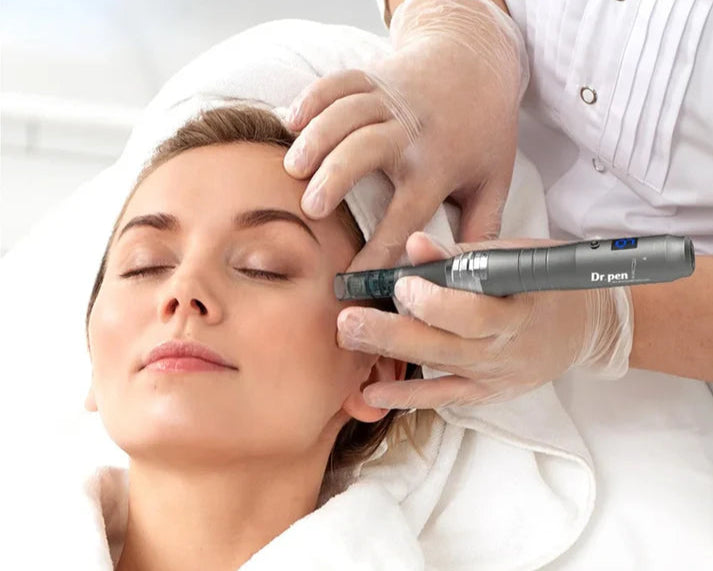Keloid scars are a type of scar that forms when the skin heals from an injury, often resulting in a raised, thickened, and sometimes painful growth. These scars can develop anywhere on the body but are most common on the chest, shoulders, and back. They are typically more prevalent in individuals with darker skin tones and can cause significant distress due to their appearance and the discomfort they may cause. Traditional treatments for keloid scars range from topical creams and injections to surgery and radiation therapy. However, in recent years, there has been growing interest in the use of microneedling pens as a potential therapeutic option.

Microneedling, also known as collagen induction therapy, involves the use of a device equipped with fine needles to create controlled micro-injuries on the skin's surface. This process stimulates the body's natural healing response, encouraging the production of collagen and elastin. Collagen is a protein that provides structure to the skin, while elastin helps it maintain its elasticity. By enhancing the production of these essential components, microneedling aims to improve skin texture, reduce the appearance of scars, and promote overall skin rejuvenation.
The microneedling pen is a handheld device that has revolutionized the field of microneedling. It allows for precise control over the depth and pattern of needle penetration, making it a versatile tool for addressing various skin concerns. When used for keloid scars, the microneedling pen can target the scarred tissue, potentially breaking down the excessive collagen fibers that contribute to the scar's raised appearance. Additionally, the micro-injuries created by the needles can stimulate the formation of new, healthier skin cells, which may help to replace the scarred tissue over time.
One of the primary benefits of using a microneedling pen for keloid scars is its minimally invasive nature. Unlike surgical procedures, microneedling does not require incisions or the removal of tissue, reducing the risk of complications and downtime. This makes it an attractive option for individuals seeking a less aggressive approach to scar management. Furthermore, microneedling can be performed in a clinician's office or even at home with the appropriate training and equipment, providing greater convenience and flexibility.
Another advantage of microneedling is its ability to enhance the absorption of topical treatments. By creating micro-channels in the skin, the microneedling process allows topical creams, serums, and other therapeutic agents to penetrate deeper into the skin's layers. This can increase the effectiveness of treatments designed to reduce inflammation, promote healing, and improve skin texture. For keloid scars, this means that combining microneedling with topical scar-reducing products may yield better results than using either treatment alone.
However, it is essential to note that microneedling for keloid scars is not without its risks. One of the primary concerns is the potential for stimulating further collagen production, which could exacerbate the scar's appearance. Keloids are characterized by an overabundance of collagen, and microneedling, by design, encourages collagen synthesis. Therefore, it is crucial to approach microneedling for keloid scars with caution and under the guidance of a qualified professional.
To minimize the risk of adverse effects, a thorough assessment of the scar and the individual's skin type should be conducted before initiating microneedling treatment. In some cases, it may be necessary to combine microneedling with other therapies, such as corticosteroid injections or silicone sheeting, to balance the stimulation of collagen production and prevent keloid recurrence. A personalized treatment plan that takes into account the individual's specific needs and risk factors is essential for achieving optimal outcomes.
In addition to the risks associated with stimulating collagen production, microneedling can also cause temporary side effects such as redness, swelling, and discomfort. These side effects are generally mild and resolve within a few days to a week. However, in rare cases, more severe complications, such as infection or pigmentation changes, can occur. To reduce the risk of complications, it is crucial to follow proper aftercare instructions and maintain good skin hygiene following the procedure.
When considering microneedling for keloid scars, it is also important to manage expectations. While microneedling can improve the appearance of scars and promote skin rejuvenation, it may not completely eliminate keloids. Multiple treatment sessions may be required to achieve noticeable results, and the degree of improvement can vary from person to person. Patience and consistency are key when undergoing microneedling therapy for keloid scars.
Moreover, the success of microneedling in treating keloid scars may depend on the scar's age, size, and location. Newer scars may respond more favorably to treatment than older, more established scars. Similarly, scars located in areas with thinner skin, such as the face or neck, may require a different approach than scars on thicker, more resilient areas of the body. A tailored treatment plan that considers these factors is essential for maximizing the effectiveness of microneedling.
In conclusion, microneedling pens offer a promising alternative to traditional treatments for keloid scars. By stimulating collagen and elastin production, microneedling has the potential to improve skin texture, reduce scar appearance, and promote overall skin rejuvenation. However, the use of microneedling for keloid scars must be approached with caution, as it carries the risk of stimulating further collagen production and exacerbating the scar's appearance. A thorough assessment, personalized treatment plan, and proper aftercare are essential for minimizing risks and maximizing outcomes. While microneedling may not completely eliminate keloid scars, it can be a valuable addition to a comprehensive scar management strategy, offering individuals a less invasive and more convenient option for improving their skin's appearance and quality of life.

Share:
How to Use a Microneedling Pen for Optimal Results
Can Microneedling Pen Help with Melasma?